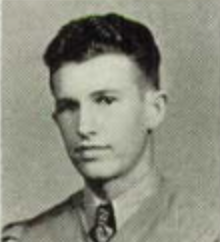Glenn Emile Duncan was born on May 19, 1918, in Berling, Texas. He was the son of Charles H Duncan and Eleanora E Duncan. He was a career officer in the United States Air Force and one of the leading aces of Eighth Air Force in World War II in Europe and the top ace of the 353rd Fighter Group. Duncan was credited with 19.5 victories, one probable victory, and seven damaged German aircraft. He also destroyed at least nine enemy aircraft on the ground, while flying P-47 Thunderbolts with the 353rd Fighter Group. He flew combat missions in the P-47 Thunderbolts and P-51 Mustangs in Europe.
Glenn enlisted in the Aviation Cadet Program of the U.S. Army Air Corps on February 9, 1940, and was commissioned a 2nd Lieutenant and awarded his pilot wings at Kelly Field, Texas, on October 5, 1940.
Duncan served as an instructor pilot for a year and then served in Panama from December 1941 to January 1943, before completing P-47 Thunderbolt training and being assigned first to the 361st Fighter Group, and then to the 353rd Fighter Group in England in March 1943.
In mid-1943, the 353rd FG was initially stationed at RAF Goxhill in Lincolnshire, England, before moving to RAF Metfield in Suffolk, England in August 1943. After switching its base to Metfield, the 353rd FG flew its first combat mission. On September 23, 1943, Duncan scored his first victory, an Fw 190 over Nantes. He began flying frequent escort missions and destroyed an Fw 190 and Bf 109 on November 11, for which he received the Distinguished Service Cross. He was made full Colonel in November 1944.
Duncan became a flying ace, when he destroyed an Fw 190 over Rastede on December 20, his fifth aerial victory. During a bomber escort near Ans, Belgium on 20th January 1944, his flight encountered four twin-engined Me 110s. In the dogfight, he destroyed two Me 110s. In April 1944, the 353rd FG moved to their new base in RAF Raydon.
By June 7, 1944, he had accumulated 15½ kills. On the 12th of June, he shot down three Bf-109s. He claimed his 19th and last aerial victory on July 5, when he shot down a Bf 109 over Pont-Audemer.
On July 7th, 1944, while leading an aerial attack on an aerodrome at Wesendorf, his P-47 was hit by anti-aircraft fire. His crippled P-47 continued to fly on until he belly-landed near Nienburg. As he left his aircraft, he tossed a grenade into it to ensure that it won't fall into the German hands, destroying the aircraft. He then evaded capture on foot and walked towards the Netherlands. He joined the Dutch resistance, before being liberated by the Allied forces 10 months later, in April 1945.
Duncan then rejoined the 353rd Fighter Group as its commanding officer, which was now equipped with the P-51 Mustang. He served until October 1945, when he returned to the U.S. He then returned to Germany and served on occupation duty from January to August 1946.
During World War II, Duncan was credited with the destruction of 19.5 enemy aircraft in the air, 7 damaged and 1 probable. He was also credited with destroying 9 enemy aircraft on the ground while strafing enemy airfields. During his time with the 353rd FG, he flew aircraft bearing the name "Dove of Peace," with code LH-X. There were P-47s and P-51 with this title in the 353rd Fighter Group at that time.
Col Duncan died on July 14, 1998, at the age of 80, in Okaloosa County, Florida. He is now buried in the Arlington National Cemetery, Arlington, Arlington County, Virginia, USA.
Source of information: www.findagrave.com, en.wikipedia.org

